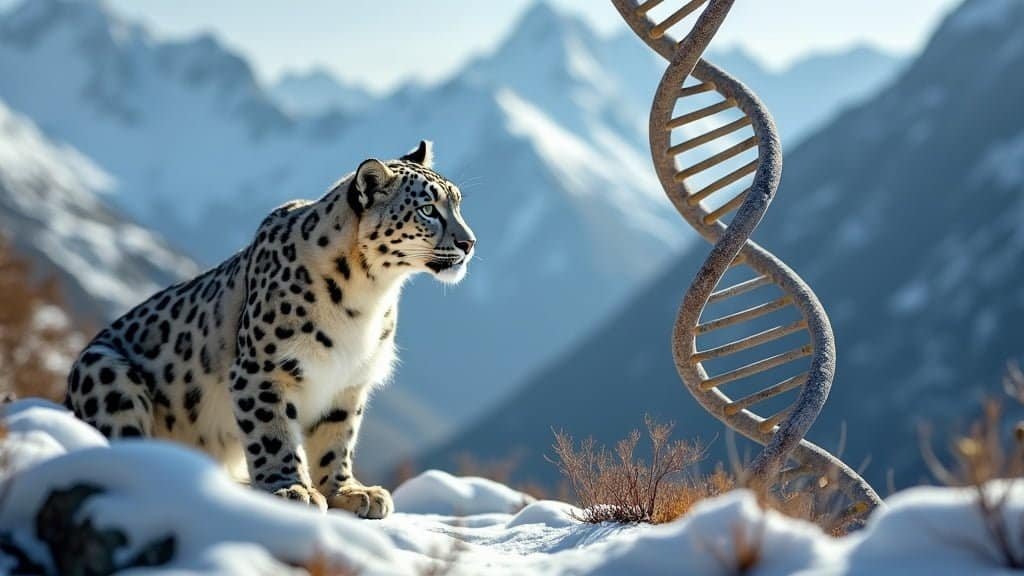Introduction
Genetic research is becoming increasingly vital in the conservation of snow leopards, a species facing numerous threats in its natural habitat. This article delves into the significant role that genetic research plays in ensuring the survival of snow leopards
We’ll explore how understanding their genetic makeup aids in population management, maintains genetic diversity, and prevents inbreeding
Additionally, we’ll look at the various genetic techniques employed, the impact on conservation strategies, and the challenges faced by researchers in this field. Finally, we’ll discuss the future prospects of genetic research in safeguarding this majestic species
The Importance of Genetic Research in Snow Leopard Conservation
Genetic research is a cornerstone of modern conservation efforts, especially for species like the snow leopard that are elusive and difficult to study in the wild. By analyzing the genetic makeup of these big cats, scientists can gain critical insights into their population structure, genetic diversity, and health
These insights are essential for developing effective conservation strategies that not only focus on increasing population numbers but also on maintaining the genetic viability necessary for the species’ long-term survival
Understanding Snow Leopard Genetics
Snow leopards (Panthera uncia) inhabit some of the most remote and rugged terrains in Central and South Asia, making direct observation and population assessments challenging
Genetic research provides a powerful alternative to traditional fieldwork by allowing scientists to analyze DNA from non-invasive samples, such as scat or hair, collected in the wild. By sequencing the DNA, researchers can identify individual leopards, assess population sizes, and understand the genetic relationships within and between different populations
One of the key findings from genetic research is the revelation of genetic differentiation among snow leopard populations across their range
A study published in 2016 by the Snow Leopard Trust and partners found that snow leopard populations are genetically distinct across different mountain ranges, such as the Himalayas, Tian Shan, and Altai mountains. This suggests that snow leopards may be divided into several sub-populations, each of which requires tailored conservation approaches
Genetic Diversity and Population Health
Genetic diversity is crucial for the long-term survival of any species, including snow leopards. High genetic diversity within a population allows it to adapt to changing environmental conditions and resist diseases
Conversely, low genetic diversity can lead to inbreeding, which increases the likelihood of hereditary diseases and reduces the population’s ability to survive in the face of environmental changes
Research has shown that snow leopard populations are already experiencing low levels of genetic diversity, which is a significant concern for their future survival. A study conducted by Janecka et al. in 2017 found that snow leopard populations across their range have limited genetic diversity, likely due to their naturally low population densities and the fragmented nature of their habitats
Conservation efforts must therefore focus on preserving and enhancing this genetic diversity by preventing further habitat fragmentation and facilitating gene flow between isolated populations
Preventing Inbreeding Through Genetic Insights
Inbreeding occurs when closely related individuals within a population mate, leading to a higher chance of offspring inheriting harmful genetic traits. For snow leopards, whose populations are already small and fragmented, inbreeding poses a significant risk
Genetic research helps conservationists identify inbred populations and take steps to increase genetic diversity, such as by introducing individuals from other populations to enhance gene flow
One practical application of this knowledge is in captive breeding programs, where genetic research is used to pair individuals in a way that maximizes genetic diversity and reduces the risk of inbreeding
Additionally, genetic studies can inform translocation efforts, where snow leopards from genetically diverse populations are relocated to areas with lower diversity to boost the genetic health of the resident population
Genetic Techniques Used in Snow Leopard Conservation
The application of advanced genetic techniques has revolutionized the conservation of snow leopards, providing tools that were previously unavailable to researchers
These techniques allow for the monitoring of populations, understanding of genetic diversity, and tracking of individual animals—all critical components of effective conservation strategies
By leveraging genetic tools, scientists can obtain detailed insights that guide conservation actions, even in the most challenging environments where direct observation of snow leopards is difficult
DNA Analysis and Population Monitoring
DNA analysis has become one of the most valuable tools in snow leopard conservation, primarily due to the species’ elusive nature
Traditional methods of estimating population sizes, such as camera trapping or direct sightings, are often inadequate in the vast and rugged terrains that snow leopards inhabit. Genetic sampling, however, provides a reliable alternative by allowing researchers to collect DNA from non-invasive sources like scat, hair, or even environmental DNA (eDNA) found in the snow or soil
Once collected, the DNA is analyzed to identify individual snow leopards within a population. This method, known as genetic fingerprinting, uses specific markers in the DNA to distinguish between individuals, much like a human fingerprint
A study conducted by Sharma et al. in 2020 utilized this technique to estimate snow leopard populations in the Indian Himalayas, providing a more accurate count than was previously possible
The ability to monitor populations at the individual level allows conservationists to track population trends over time, assess the success of conservation efforts, and detect any signs of decline early
Genetic Markers and Their Role in Conservation
Genetic markers are specific sequences in the DNA that can be used to study the genetic diversity and structure of populations. These markers are critical in identifying distinct populations, understanding their evolutionary history, and assessing their genetic health
In snow leopards, microsatellites (short, repetitive DNA sequences) and single nucleotide polymorphisms (SNPs) are commonly used genetic markers
Microsatellites are particularly useful for studying genetic diversity within a population. They can reveal how closely related individuals are, which is important for managing breeding programs and preventing inbreeding
SNPs, on the other hand, provide insights into the evolutionary relationships between different populations of snow leopards. A study published in 2019 by Weckworth et al. used SNP analysis to show that snow leopard populations in different regions have distinct genetic signatures, which has important implications for conservation planning
Protecting these distinct populations is crucial for maintaining the overall genetic diversity of the species
Non-invasive Genetic Sampling Methods
One of the significant advancements in snow leopard conservation has been the development of non-invasive genetic sampling methods
These methods involve collecting DNA without the need to capture or even directly observe the animals, which is especially important for a species as elusive and endangered as the snow leopard
Scat collection is one of the most common non-invasive methods. Researchers hike through snow leopard habitats, collecting fecal samples that can be analyzed in the lab for DNA
This method not only helps identify individual leopards but also provides information on their diet, health, and territory use. Another non-invasive technique is collecting hair samples, which snow leopards may leave behind on rough surfaces like rocks or tree branches. These samples are less common but can provide high-quality DNA for analysis
Environmental DNA (eDNA) is an emerging method that involves analyzing DNA that animals leave behind in their environment. For snow leopards, this could mean analyzing DNA from snow, water, or soil where they have been active
This method is still in the early stages of development but has the potential to revolutionize how researchers monitor snow leopard populations in vast and inaccessible areas
Impact of Genetic Research on Conservation Strategies
Genetic research plays a pivotal role in shaping and refining conservation strategies for snow leopards. By providing a deeper understanding of the species’ genetic health, population structure, and movement patterns, genetic insights inform targeted actions that enhance the effectiveness of conservation efforts
This approach not only helps to identify at-risk populations but also ensures that conservation policies are based on scientific evidence, maximizing their impact on the preservation of this endangered species
Identifying Endangered Populations
One of the most critical contributions of genetic research to snow leopard conservation is the ability to identify populations that are most at risk
Traditional conservation efforts often focus on areas where snow leopards are known to exist, but without genetic insights, it can be challenging to determine which populations are genetically distinct and, therefore, may require more urgent protection
For example, genetic studies have revealed that snow leopards in the Himalayas are genetically distinct from those in other parts of their range, such as the Tian Shan or Altai mountains
This information is vital because it suggests that these populations have been isolated for long periods, leading to unique genetic adaptations that could be lost if the population declines. Conservation efforts can then be tailored to protect these distinct populations, such as by creating wildlife corridors that facilitate gene flow between fragmented habitats or by prioritizing these areas for anti-poaching efforts
Furthermore, genetic research has been instrumental in identifying so-called “genetic bottlenecks,” where a population’s genetic diversity has been severely reduced due to a drastic decrease in numbers
Populations that have gone through a bottleneck are at a higher risk of extinction because they lack the genetic diversity needed to adapt to environmental changes. By identifying these bottlenecked populations, conservationists can implement strategies to increase genetic diversity, such as through managed breeding programs or translocations
Influencing Conservation Policies
Genetic research has a direct impact on the development and implementation of conservation policies. By providing concrete data on the genetic health and structure of snow leopard populations, scientists can advocate for policies that address specific threats and promote sustainable conservation practices
For instance, the Convention on International Trade in Endangered Species of Wild Fauna and Flora (CITES) relies on genetic data to monitor and regulate the illegal trade of snow leopard parts
Genetic research enables authorities to trace the origin of confiscated snow leopard products, helping to crack down on poaching networks and illegal trafficking. Moreover, this genetic information can be used to strengthen international agreements and enforcement measures aimed at protecting snow leopards across their range
On a regional level, genetic research informs the creation of protected areas and wildlife corridors. For example, studies showing the genetic connectivity between snow leopard populations in different mountain ranges can lead to the establishment of transboundary protected areas, which are crucial for maintaining gene flow between populations
These areas ensure that snow leopards can move freely across their natural range, reducing the risk of inbreeding and allowing for healthier, more resilient populations
Tracking Migration and Habitat Use
Understanding snow leopard migration patterns and habitat use is essential for their conservation, and genetic research provides a powerful tool for tracking these movements
Unlike GPS collars, which are expensive and difficult to deploy in remote areas, genetic sampling can be done more easily and can provide valuable data on how snow leopards move across the landscape
For example, by analyzing genetic samples from different locations, researchers can determine if snow leopards are moving between populations or if certain areas act as barriers to movement
A study conducted by the Wildlife Conservation Society in 2021 used genetic data to show that snow leopards in the Pamir Mountains regularly move across international borders between Afghanistan, Tajikistan, and China. This information is crucial for cross-border conservation efforts, as it highlights the need for international cooperation to protect these migratory corridors
Additionally, genetic research helps to identify critical habitats that are essential for the survival of snow leopards. By understanding which areas support the highest genetic diversity or serve as key movement corridors, conservationists can prioritize these habitats for protection
This approach ensures that limited conservation resources are used most effectively to safeguard the species
Challenges and Future Prospects of Genetic Research
Despite the significant advancements in genetic research for snow leopard conservation, several challenges remain. These obstacles include technical difficulties, limited resources, and the inherent complexity of studying an elusive species in remote environments
However, with continued innovation and collaboration, the future of genetic research holds promising potential to overcome these challenges and further enhance conservation efforts for snow leopards
Overcoming Challenges in Genetic Research
One of the primary challenges in snow leopard genetic research is the difficulty in obtaining high-quality DNA samples. Snow leopards inhabit some of the most rugged and inaccessible terrains in the world, often at high altitudes with harsh weather conditions
This makes fieldwork challenging and limits the frequency with which samples can be collected. Additionally, the DNA extracted from non-invasive sources like scat or hair can be degraded or contaminated, making it difficult to obtain clear and reliable genetic data
To address these challenges, researchers have developed new techniques for collecting and analyzing DNA. For instance, advancements in next-generation sequencing (NGS) have made it possible to analyze even low-quality DNA samples more effectively
NGS allows researchers to sequence entire genomes from small or degraded samples, providing a wealth of genetic information that was previously inaccessible. This technology is particularly useful for studying snow leopards, where high-quality samples are rare
Another significant challenge is the cost of genetic research. The technologies involved, such as DNA sequencing and analysis, are expensive, and funding for wildlife conservation is often limited. As a result, many snow leopard conservation projects must carefully allocate resources, balancing the need for genetic research with other critical activities like anti-poaching efforts and community engagement
Collaborative efforts and partnerships with academic institutions, NGOs, and government agencies have been essential in pooling resources and expertise to advance genetic research despite these financial constraints
Future Directions for Genetic Studies
As genetic research continues to evolve, several exciting new directions hold promise for snow leopard conservation. One such area is the use of genomic studies to better understand the adaptive traits of snow leopards. By comparing the genomes of snow leopards from different environments, researchers can identify genes associated with adaptations to cold climates, high altitudes, and prey availability
Understanding these genetic adaptations could help conservationists predict how snow leopard populations might respond to environmental changes, such as global warming or habitat loss
Another promising area of research is the use of gene editing technologies, such as CRISPR, to aid in conservation efforts
While still in the early stages of exploration, gene editing could potentially be used to address genetic issues like inbreeding or disease susceptibility in small, isolated populations. However, this approach raises ethical and ecological concerns that must be carefully considered before implementation
Additionally, the integration of genetic data with other types of ecological and behavioral data is likely to play an increasingly important role in conservation planning. For example, combining genetic information with data from GPS collars, camera traps, and remote sensing can provide a more comprehensive understanding of snow leopard ecology
This integrated approach allows for more precise conservation strategies that account for both the genetic health of populations and their interactions with the environment
The Role of Technology in Advancing Research
Technological advancements are driving the future of genetic research in snow leopard conservation. One of the most promising developments is the rise of environmental DNA (eDNA) techniques
As mentioned earlier, eDNA allows researchers to detect the presence of snow leopards by analyzing DNA from environmental samples like snow, water, or soil. This method is particularly useful in areas where snow leopards are rare or difficult to observe directly
As eDNA techniques become more refined and accessible, they are likely to become a standard tool for monitoring snow leopard populations across their range
Another area where technology is making a significant impact is in data analysis. The large datasets generated by genetic studies require advanced computational tools to analyze and interpret. Machine learning and artificial intelligence (AI) are increasingly being used to identify patterns in genetic data that might be missed by traditional analysis methods
For example, AI can help predict which populations are at risk of genetic decline or identify key genetic markers associated with disease resistance or environmental adaptation
Finally, technology is enhancing the ability of researchers to collaborate and share data. Online platforms and databases allow scientists from around the world to access and contribute to genetic research on snow leopards
This collaborative approach not only speeds up the research process but also ensures that conservation strategies are informed by the most up-to-date and comprehensive genetic information available
Conclusion
Genetic research has become an indispensable tool in the conservation of snow leopards, providing insights that are crucial for ensuring their long-term survival. From identifying endangered populations and enhancing genetic diversity to informing conservation policies and tracking migration patterns, the applications of genetic research are vast and impactful
Despite challenges such as the difficulty of obtaining high-quality samples and the costs associated with advanced technologies, continued innovation in this field offers promising prospects. As technology advances and genetic techniques become more refined, they will likely play an even greater role in protecting snow leopards, ensuring that conservation efforts are both effective and scientifically sound
The ongoing integration of genetic data into broader conservation strategies is key to safeguarding the future of this elusive and majestic species







